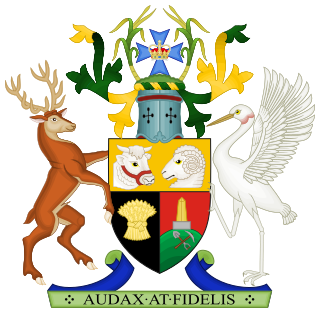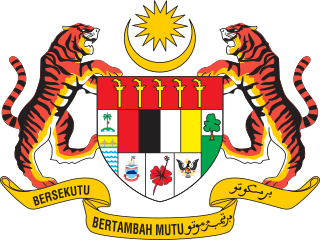
The Executive Office of the President (EOP) comprises the offices and agencies that support the work of the president at the center of the executive branch of the United States federal government. The EOP consists of several offices and agencies, such as the White House Office, the National Security Council, and the Office of Management and Budget.

The Welsh Government is the devolved government of Wales. The government consists of ministers, who attend cabinet meetings, and deputy ministers who do not, and also of a counsel general. It is led by the first minister, usually the leader of the largest party in the Senedd, who selects ministers and deputy ministers with the approval of the Senedd. The government is responsible for tabling policy in devolved areas for consideration by the Senedd and implementing policy that has been approved by it.
A cabinet secretary is usually a senior official who provides services and advice to a cabinet of ministers as part of the Cabinet Office. In many countries, the position can have considerably wider functions and powers, including general responsibility for the entire civil service.

The Queensland Government is the executive administrative authority of the Australian state of Queensland. The Government of Queensland, a parliamentary constitutional monarchy was formed in 1859 as prescribed in its Constitution, as amended from time to time. Since the Federation of Australia in 1901, Queensland has been a State of Australia, with the Constitution of Australia regulating the relationships between all state and territory governments and the Australian Government. Under the Australian Constitution, all states and territories ceded powers relating to certain matters to the federal government.

Michael John Ahern is a former Queensland National Party politician who was Premier of Queensland from December 1987 to September 1989. After a long career in the government of Sir Joh Bjelke-Petersen, Ahern became his successor amid the controversy caused by the Fitzgerald Inquiry into official corruption. Ahern's consensus style and political moderation contrasted strongly with Bjelke-Petersen's leadership, but he could not escape the division and strife caused by his predecessor's downfall.
A Department of State of Ireland is a department or ministry of the Government of Ireland. The head of such a department is called a Minister of the Government; prior to 1977 such ministers were called Ministers of State, a term now used for junior (non-cabinet) ministers. Most members of the government are Ministers of the Government, though there may occasionally be a minister without portfolio who does not head a department of state. The law regarding the departments of state and ministers of the government is based in the Constitution of Ireland, primarily in Article 28, with legislative detail in the Ministers and Secretaries Acts 1924 to 2020.

The civil service in Malaysia is pivotal around Article 132 of the Constitution of Malaysia which stipulates that the public services shall consist of the Federal and State General Public Service, the Joint Public Services, the Education Service, the Judiciary and the Legal Service and the Armed Forces.
The machinery of government is the interconnected structures and processes of government, such as the functions and accountability of departments in the executive branch of government. The term is used particularly in the context of changes to established systems of public administration where different elements of machinery are created.

Annastacia Palaszczuk is an Australian politician who has been the Premier of Queensland since 2015 and the Leader of the Labor Party in Queensland since 2012. She was first elected to the Legislative Assembly of Queensland for the seat of Inala at the 2006 election.

The Australian Public Service (APS) is the federal civil service of the Commonwealth of Australia responsible for the public administration, public policy, and public services of the departments and executive and statutory agencies of the Government of Australia. The Australian Public Service was established at the Federation of Australia in 1901 as the Commonwealth Public Service and modelled on the Westminster system and United Kingdom's Civil Service. The establishment and operation of the Australian Public Service is governed by the Public Service Act 1999 of the Parliament of Australia as an "apolitical public service that is efficient and effective in serving the Government, the Parliament and the Australian public". The conduct of Australian public servants is also governed by a Code of Conduct and guided by the APS Values set by the Australian Public Service Commission.
The Public Service of Canada is the civil service of the Government of Canada. Its function is to serve as the staff of the Canadian Crown. The Clerk of the Privy Council, as Canada's senior serving civil servant, is head of the Public Service of Canada.

The Government of the United Kingdom, domestically referred to as Her Majesty's Government, is the central government of the United Kingdom of Great Britain and Northern Ireland. The government is led by the prime minister, who selects all the other ministers. The prime minister and their most senior ministers belong to the supreme decision-making committee, known as the Cabinet.

In Australia, a departmental secretary is the most senior public servant of an Australian Government or state government department. They are typically responsible for the day-to-day actions of a department.

The New South Wales Department of Premier and Cabinet (DPC), a department of the New South Wales Government, is responsible for leading the New South Wales public sector to deliver on the Government's commitments and priorities. The department provides administrative support that enables the cabinet to identify, design and implement a coordinated policy, project and reform agenda that boosts the efficiency, productivity and effectiveness across the State. The department consults and work closely with other New South Wales government departments, the Commonwealth Government, local government, business and the community to ensure responses to community needs are effective.

The politics of France take place with the framework of a semi-presidential system determined by the French Constitution of the French Fifth Republic. The nation declares itself to be an "indivisible, secular, democratic, and social Republic". The constitution provides for a separation of powers and proclaims France's "attachment to the Rights of Man and the principles of national sovereignty as defined by the Declaration of 1789."
The Department of Education is a ministerial department of the Queensland Government responsible for the administration and quality of education in Queensland, Australia. The department is composed of two separate portfolios, Education Queensland and Early Childhood Education and Care (ECEC). The department also encompasses the Queensland Curriculum and Assessment Authority, a separate statutory authority responsible for creating syllabuses, curriculums, and assessment.
The Auditor-General of New South Wales helps the Parliament of New South Wales hold government accountable for its use of public resources.
The Department of Housing and Public Works (HPW) is a ministerial department within the Queensland Government, tasked with providing housing, sport, digital technology, and urban design and architecture services to Queensland individuals and businesses. HPW is also responsible for providing procurement, office space and digital services to Queensland Government departments.
















